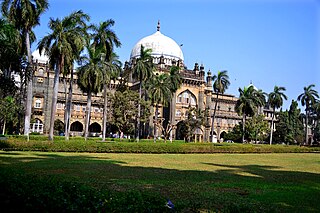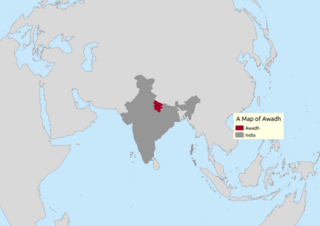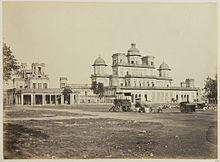
Chhatrapati Shivaji Maharaj Vastu Sangrahalaya, (CSMVS) originally named Prince of Wales Museum of Western India, is a museum in Mumbai (Bombay) which documents the history of India from prehistoric to modern times.

Awadh, known in British historical texts as Avadh or Oudh, is a historical region in northern India, now constituting the northeastern portion of Uttar Pradesh. It is roughly synonymous with the ancient Kosala region of Hindu, Buddhist, and Jain scriptures.

Indian art consists of a variety of art forms, including painting, sculpture, pottery, and textile arts such as woven silk. Geographically, it spans the entire Indian subcontinent, including what is now India, Pakistan, Bangladesh, Sri Lanka, Nepal, and at times eastern Afghanistan. A strong sense of design is characteristic of Indian art and can be observed in its modern and traditional forms.

Farrukhabad district is a district of Uttar Pradesh state in Northern India. The town of Fatehgarh is the district headquarters. The district is part of Kanpur Division.

The National Museum in New Delhi, also known as the National Museum of India, is one of the largest museums in India. Established in 1949, it holds a variety of articles ranging from pre-historic era to modern works of art. It functions under the Ministry of Culture, Government of India. The museum is situated on Janpath. The blue–print of the National Museum had been prepared by the Gwyer Committee set up by the Government of India in 1946. The museum has around 200,000 works of art, mostly Indian, but some of foreign origin, covering over 5,000 years.

The Peshawar Museum is a museum located in Peshawar, capital of Pakistan's Khyber Pakhtunkhwa province. The Peshawar Museum is notable for its collection of Buddhist artwork dating from the ancient Gandhara region.

The Watson Museum, considered to be one of the best among the seven such museums located across Saurashtra (region) and managed by the Gujarat state Government, it has collections of precious objects from the princely State of Rajkot founded by the Jadeja Rajputs. It holds invaluable articles, artifacts, photographs, a reference library and the museum's publication are sold through a counter.

Government Museum and Art Gallery, Chandigarh, is a premier museum of North India having collections of Gandharan sculptures, sculptures from ancient and medieval India, Pahari and Rajasthani miniature paintings. It owes its existence to the partition of India in August, 1947. Prior to the partition, much of the collections of art objects, paintings and sculptures present here were housed in the Central Museum, Lahore, the then capital of Punjab. The museum has one of the largest collection of Gandharan artefacts in the world.

The Culture of Uttar Pradesh is an Indian culture which has its roots in Hindi, Bhojpuri and Urdu literature, music, fine arts, drama and cinema. Lucknow, the capital of Uttar Pradesh, has historical monuments including Bara Imambara and Chhota Imambara, and has preserved the damaged complex of the Oudh-period British Resident's quarters, which are being restored.
Nawab Wajid Ali Shah Prani Udyan, earlier known as Prince of Wales Zoological Gardens or popularly known as Lucknow Zoological Garden, and Banaarsi Baag, is a 71.6-acre (29.0 ha) zoo located in the heart of the capital city of Uttar Pradesh named after Wajid Ali Shah - the last Nawab of Awadh. According to the Central Zoo Authority of India, it is a large zoo. The Prince of Wales Zoological Gardens, was established in the year 1921 to commemorate the visit of the Prince of Wales to Lucknow. The idea of establishing Zoological gardens at Lucknow emanated from Sir Harcourt Butler, the Governor of the State.

Lalbhai Dalpatbhai Museum, abbreviated L. D. Museum, is a museum of Indian sculptures, bronzes, manuscripts, paintings, drawings, miniature paintings, woodwork, bead work and ancient and contemporary coins in Ahmedabad, Gujarat, India.

Government Museum, Mathura, commonly referred to as Mathura museum, is an archaeological museum in Mathura city of Uttar Pradesh state in India. The museum was founded by then collector of the Mathura district, Sir F. S. Growse in 1874. Initially, it was known as Curzon Museum of Archaeology, then Archaeology Museum, Mathura, and finally changed to the Government Museum, Mathura.

Uttar Pradesh, a state in north India has a long association with Jainism. Today the state is home to a number of Jain monuments, such as Jain Temples and Jain Tirths. There are around 213,267 Jains in Uttar Pradesh according to 2011 Census of India.

Government Museum, Bangalore, established in 1865 by the Mysore State with the guidance of Surgeon Edward Balfour who founded the museum in Madras and supported by the Chief Commissioner of Mysore, L.B. Bowring, is one of the oldest museums in India and the second oldest museum in South India. It is now an archaeological museum and has a rare collection of archaeological and geological artifacts including old jewellery, sculpture, coins and inscriptions. The museum is also home to the Halmidi inscription, the earliest Kannada inscription.
The Northern Satraps, or sometimes Satraps of Mathura, or Northern Sakas, are a dynasty of Indo-Scythian rulers who held sway over the area of Punjab and Mathura after the decline of the Indo-Greeks, from the end of the 1st century BCE to the 2nd century CE. They are called "Northern Satraps" in modern historiography to differentiate them from the "Western Satraps", who ruled in Sindh, Gujarat and Malwa at roughly the same time and until the 4th century CE. They are thought to have replaced the last of the Indo-Greek kings in the Punjab region, as well as the Mitra dynasty and the Datta dynasty of local Indian rulers in Mathura.

The Art of Mathura refers to a particular school of Indian art, almost entirely surviving in the form of sculpture, starting in the 2nd century BCE, which centered on the city of Mathura, in central northern India, during a period in which Buddhism, Jainism together with Hinduism flourished in India. Mathura "was the first artistic center to produce devotional icons for all the three faiths", and the pre-eminent center of religious artistic expression in India at least until the Gupta period, and was influential throughout the sub-continent.
The Sardar Government Museum is located in Public Park, Jodhpur, Rajasthan, India. The museum is named in memory of Maharaja Sardar Singh, a ruler of Jodhpur from 1895 to 1911. It was constructed under the reign of his son, Maharaja Umed Singh. It was built by Henry Vaughan Lanchester in 1909 and formally opened to the public on 17 March, 1936. The area of the museum is approx. 18,000 sq.ft. On 22 June 2018, the re-planned museum was inaugurated by Smt. Vasundhara Raje, the Chief Minister of Rajasthan.

Gupta art is the art of the Gupta Empire, which ruled most of northern India, with its peak between about 300 and 480 CE, surviving in much reduced form until c. 550. The Gupta period is generally regarded as a classic peak and golden age of North Indian art for all the major religious groups. Gupta art is characterized by its "Classical decorum", in contrast to the subsequent Indian medieval art, which "subordinated the figure to the larger religious purpose".

State Museum is a museum in Bhopal. It is located on Shymala Hills, Madhya Pradesh state of India. It is popular for its design and the best art and culture of Madhya Pradesh. The museum holds a very prominent role among the monuments and museums of Bhopal.


























